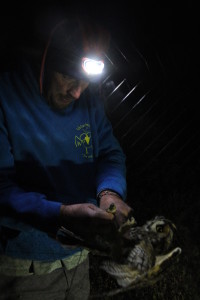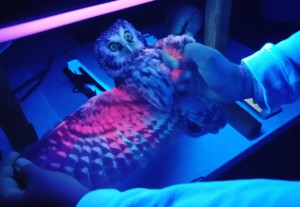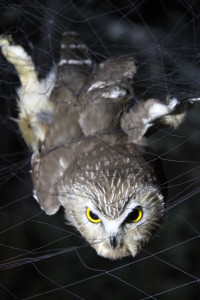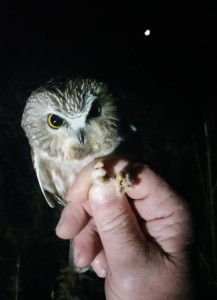Give a Hoot!
Give a Hoot – Owl Attraction
Owls in Abundance – Banding Evidence
Nocturnal Nature and Volunteers
by Back Roads Bill
What is it about owls that so captivates us? The answer may be a simple one. Owls inhabit the one landscape that we weak-sighted, day-loving primates still haven’t mastered. Night-time.
There is the expression “I don’t give a hoot” but on the contrary there are others who do because as volunteers they like and care about owls. They are the real “night owls” because they like working in the dead of night. Owls are stereotyped for their hooting calls, but a number of species don’t hoot at all.
Owls stand out among all living bird groups. These slightly anthropomorphic winged creatures have conquered the night, while nearly all other birds are confined to the daylight. And just so you know, owls can rotate their heads 270 degrees, lots of little neck bones and flexible arteries allow for the mobility. We humans can rotate our heads less than a third of that. While the stereotype of the “wise owl” is well established, owls can be regarded as demonic symbols or harbingers of doom. Connections to witchcraft are often made as well. Owls have also risen to prominence as icons in popular culture, such as the famous Hedwig, the snowy owl featured in the Harry Potter series.
A Wise Place

Extracting from the mist net
But let’s go to the marsh, the Hillardton Marsh (HM). If you are a “birder” or not, the HM, just north of Temiskaming Shores (New Liskeard) comprises 728 hectares (1798 acres); it is designated as a provincially significant wetland and wildlife area. A marsh is different from a swamp, fen or bog, it is an area of low-lying land that is flooded in wet seasons and typically remains waterlogged at all times. It is also the home for the Hilliardton Marsh Bird & Wetland Research & Education Centre. It is one of two observatories in Northern Ontario, the other being Thunder Cape Bird Observatory east of Thunder Bay. It is home to more than 600 species of waterfowl, songbirds, mammals, fish and plant life. HM is continentally significant for waterfowl migrating to and from the James Bay and Hudson Bay lowlands. Because of the five-star habitat it is an important stopover for the owls. It is a tourism destination of sorts, a couple from Iowa celebrating their 25th anniversary made it a mutual vow and travelled the 2000 km to have their photo taken with a boreal owl.
There are many volunteers there, in particular two special species. Bruce Murphy, a local high school teacher, is a founding HM pioneer. His own passion developed during his childhood, Grade 6 field trip to the Toronto Island field school where a single chickadee was banded. But he prefers owls. Joanne Goddard is Vice-President on the HM Board of Directors and a local elementary school teacher. She is part of the dynamic duo with Bruce. “Part of our passion about banding is to see the look on young and old alike when they hold a owl for the first time. You can never anticipate the impact it will have but you know they are forever changed.”

Blacklight health check
Joanne cites good reasons as to why people have affection for owls. “Well there are obvious research reasons, the more we learn, the more questions we have, and there is so much to learn… but I would say the real reason is because owls are so freaking cool! I mean they are cute and powerful and mysterious and secretive all at once! Everyone loves owls. The fact that they are nocturnal and rarely seen by most people makes them so much more alluring. At school my students love to learn about night creatures, and adults are no different. When we are walking though forest without head lamps anticipating owls in our nets, it is like going on a mini adventure every time. And I never get tired of the reaction of our guests when we take a saw whet out of a bird bag for them to see for the first time! That choral “awwwhhhhh” is priceless!“
The HM is affiliated with Project Owlnet it is a continent wide effort to monitor the migratory ecology and population dynamics of the northern saw-whet owl. This study involves intensive continuous effort mist netting and banding. This diminutive owl is solely nocturnal. Their migratory route takes them from northern Canada to southern Georgia. Due to their small size, they are prey for larger owls and so they tend to remain silent while on the migration. Joanne says, “In order to capture or attract these owls to our banding station, we play a lure tape. All owls that visit our station are measured, banded, and released unharmed. We hope that these owls will be recaptured at another station so that we may learn more about their movements.”
Owl Audio

Sawhet in the mist net
The status of the Northern saw whet owls has changed because of the lure call. Years ago this species were not normally spotted in the day due to their habit of perching near the trunk of a tree and not many were banded. Bruce said, “Now with the encouragement of research by Project Owlnet we know they are the most abundant owl in North America. Many of owls we banded show up across the American north-east, the majority seem to find their way to Pennsylvania and West Virginia, New York and across southern Ontario. As well every year we usually catch a number of birds that have been banded originally by other banders; so far this year we have captured six birds that we call “foreign birds” as well every year we catch 1 or 2 of our birds that come back to the marsh.”
“We band owls because our location is on the edge of the boreal forest and gives us a unique opportunity to band these birds and provide an opportunity for researches to see the distribution of a denizen of the boreal.” (Yes it was looked up…” an inhabitant or occupant of particular places.”). He said, “Owls are such incredible creatures that people are drawn to. I could tell people that we caught an incredible rare warbler at the marsh but tell them that we caught 40 saw whet owls last night and they are instantly engaged, show them an owl up close and I have a friend for life. More importantly it hopefully gives people pause to think about the importance of the boreal forest which is where these birds breed.”
Owl Stats

Ready for release
Joanne and Bruce identified the impressive stats. In 2012 HM broke a North American record with 202 boreal owls. As a comparison, before the audio owl calls were used as a lure, in 1969 only 62 saw whets were banded in the entire province; with 31 at HM. This year alone at HM this year volunteers have banded 473 saw whets and 58 boreals. The best night has been a high of 13 owls including one night of the “triple crown” (saw whet, boreal and long eared; Back Roads Bill was there). “The first night we played the long eared call we banded seven,” said Bruce. The total of the province hovers around eleven. Very few target them in the province so very little is known. To tell you the truth I am in shock at how many we have been catching which fills us full of questions.”
Thanksgiving weekend we had 200 visitors in two nights and they were overjoyed that we could catch some owls for them. We are always striving to balance our research with our proud tradition of educating the public about the research we are doing and the numbers we are able to band. Internationally because the birds have no borders the banding community is certainly excited about the research we are carrying out and we are poised to take on some new initiatives and we are always looking for partnerships with universities and colleges.”
What about a full, “owl” moon? Joanne and Bruce said the full moon phase is “counter intuitive.” Apparently a full moon reduces the chance for catching owls, the new moon phase is best. Another factor owls move best when the air is cold. “We have had occasions when we have caught 40 owls at 2° C and then it goes to 15°C and we catch one owl. Is it the prey that feels vulnerable or is it the owls cannot fly well with a full moon, kind of like driving into a setting sun!”
HM is 180 km north of North Bay, 15 km southeast of Englehart. From the south turn east on Highway 569 and travel 11.9 km (over the bridge at Hilliardton) to Wool Mill Rd. It is located in the scenic Belle Vallée, take a back roads drive through the Little Clay Belt, a rural farming area with an expansive view.
Is it because of their silence in flight or their eerie vocalisations? Owls loom at us out of the darkness with a rich sense of mystery. Mother Nature is always speaking to us. And contrary to the meaning of “I couldn’t give two hoots” these birders have been taught by the teacher, herself, with wise words from the night.
